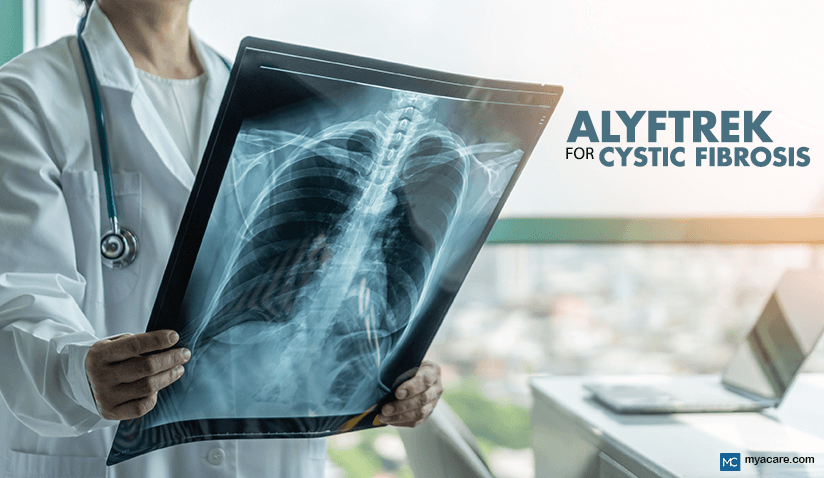Next-Gen CF Therapy: Understanding Alyftrek

Medically Reviewed by Dr. Sony Sherpa, (MBBS)
Cystic Fibrosis and the CFTR Gene
Alyftrek vs. Previous CFTR Modulators
Eligibility and Target Populations
Cystic fibrosis (CF) is a life-threatening genetic disorder that primarily affects the lungs and digestive system. The disease, which affects mucus production, leads to recurring infections, progressive lung damage, and, ultimately, respiratory failure. Beyond the lungs, CF impacts the pancreas, liver, intestines, and reproductive organs, significantly affecting patients' quality of life and life expectancy.
According to the Cystic Fibrosis Foundation, approximately 40,000 children and adults are living with cystic fibrosis in the United States, and an estimated 105,000 people have been diagnosed with CF across 94 countries worldwide. Additionally, about 1 in 30 people in the United States is a carrier of a CF gene mutation.
The advent of CFTR modulators has revolutionized CF treatment by targeting the underlying genetic defect. Among these, Alyftrek (also known as vanza triple), approved by the U.S. Food and Drug Administration (FDA) in December 2024, has emerged as a significant advancement.
Understanding Cystic Fibrosis and the CFTR Gene
The root cause of cystic fibrosis is a mutation in the CFTR gene. The gene encodes a protein that regulates the transit of sodium and chloride ions and water across epithelial membranes in various tissues, notably the lungs. In healthy individuals, the CFTR protein maintains the balance of salt and water on epithelial surfaces, ensuring thin, free-flowing mucus. However, mutations in the CFTR gene disrupt this function, leading to the accumulation of thick, dehydrated mucus.
The most common CFTR mutation is F508del, present in 30-80% of CF patients. This mutation results in misfolded CFTR proteins that are degraded before reaching the cell surface, leading to impaired ion transport and the characteristic symptoms of CF. The disease affects multiple organs:
- Lungs: Chronic infections, inflammation, and progressive lung damage.
- Pancreas: Blocked ducts leading to enzyme insufficiency and malnutrition.
- Liver: Bile duct obstruction causing liver disease.
- Intestines: Obstruction and difficulty in nutrient absorption.
- Reproductive system: Infertility, particularly in males.
What is Alyftrek?
Alyftrek is a triple combination therapy comprising vanzacaftor, tezacaftor, and deutivacaftor. The formulation aims to enhance CFTR protein quantity and function at the cell surface, leading to improved ion transport and reduced mucus viscosity.
Triple Drug Combination for Cystic Fibrosis
Triple therapy for cystic fibrosis involves the use of three CFTR modulators that work synergistically:
- Vanzacaftor: A newer type of corrector that helps the CFTR protein fold correctly and get to the cell surface.
- Tezacaftor: Another corrector that works in tandem with vanzacaftor to enhance CFTR protein processing.
- Deutivacaftor: A potentiator that increases the opening probability of the CFTR channel, enhancing ion transport.
This triple combination targets specific CFTR mutations, notably F508del, by addressing both the quantity and function of the CFTR protein.
Difference Between Alyftrek and Previous CFTR Modulators
Alyftrek (vanzacaftor/tezacaftor/deutivacaftor) represents a next-generation CFTR modulator, building upon the advancements of previous therapies like Kalydeco (ivacaftor), Symdeko (tezacaftor/ivacaftor), and Trikafta (elexacaftor/tezacaftor/ivacaftor). 1 While earlier modulators targeted specific defects in the CFTR protein, such as improving the gating function (Kalydeco), increasing the amount of protein at the cell surface (tezacaftor component of Symdeko and Trikafta), or a combination of both (Symdeko and Trikafta), Alyftrek incorporates novel molecules (vanzacaftor and deutivacaftor) alongside tezacaftor. This combination is designed to offer similar or better efficacy than Trikafta, potentially improving CFTR protein functionality. Additionally, Alyftrek has been approved for some rare mutations that were not responsive to previous CFTR modulators, expanding the treatment options for a wider range of individuals with cystic fibrosis.
Alyftrek vs. Trikafta
Trikafta, an earlier triple combination therapy comprising elexacaftor, tezacaftor, and ivacaftor, has been a cornerstone in CF treatment. However, Alyftrek offers several advantages:
- Once-Daily Dosing: Alyftrek simplifies the treatment regimen with once-daily administration, compared to Trikafta's twice-daily dosing.
- Expanded Mutation Coverage: Alyftrek is approved for patients with at least one F508del mutation or another responsive mutation, including 31 additional mutations not responsive to other CFTR modulators.
- Improved Sweat Chloride Reduction: Clinical trials demonstrated that Alyftrek further decreased sweat chloride levels compared to Trikafta, indicating enhanced CFTR function.
- Age group: Trikafta is only recommended in children 12 years and above, as its safety and efficacy in children below 12 years has not been established. Alyftrek has been approved by the FDA for children 6 years and above.
Clinical Trials: The SKYLINE Studies
The efficacy and safety of Alyftrek were evaluated in the SKYLINE 102 and SKYLINE 103 studies, the most comprehensive Phase 3 program conducted in CF. These trials included over 1,000 patients across more than 20 countries. Key findings include:
- Lung Function: Alyftrek was non-inferior to Trikafta in improving predicted forced expiratory volume in one second (ppFEV1), a measure of lung function.
- Sweat Chloride Reduction: Alyftrek achieved greater reductions in sweat chloride levels, a biomarker of CFTR activity.
- Safety Profile: Alyftrek was generally well-tolerated, with a safety profile comparable to Trikafta.
Eligibility and Target Population
Alyftrek is approved for CF patients aged 6 years and older who have at least one F508del mutation or another responsive mutation in the CFTR gene. This includes patients with 31 additional mutations not previously responsive to other CFTR modulators.
The Role of Genetic Testing
Genetic testing plays a vital role in determining eligibility for Alyftrek. A comprehensive CFTR mutation panel should be conducted to identify the presence of at least one F508del mutation or one of the 31 additional responsive mutations.
The precision of CFTR modulator therapy lies in its personalized approach - ensuring that only those with responsive mutations receive the therapy, optimizing both safety and efficacy.
In light of Alyftrek’s broader mutation responsiveness, genetic retesting or reanalysis using updated panels may be warranted for patients previously deemed ineligible for CFTR modulators.
Special Considerations
- Liver Impairment: Alyftrek is contraindicated in patients with severe hepatic impairment (Child-Pugh Class C). Its use is generally not recommended in patients with moderate hepatic impairment (Child-Pugh Class B) unless a careful risk-benefit assessment suggests that the potential benefits outweigh the risks. Close monitoring is important for patients with mild liver dysfunction (Child-Pugh Class A). Patients with a history of liver disease or abnormal liver enzymes require liver function tests before starting treatment and regularly throughout.
- Use in Children: While Alyftrek is approved for patients aged 6 and above, studies in younger children are ongoing. Pediatric use requires careful consideration of weight-based dosing and monitoring for potential side effects, including liver enzyme elevations.
- Drug Interactions: Alyftrek is metabolized by cytochrome P450 enzymes, especially CYP3A. Concomitant use with strong CYP3A inhibitors or inducers may alter drug levels and efficacy. Potential interactions may require dose adjustments or alternative medications.
Administration and Dosage
Alyftrek is administered orally as a once-daily dose, typically in the morning with food. This food requirement enhances the absorption of the active components, particularly the lipophilic modulators like vanzacaftor and deutivacaftor.
The standard dosage includes a fixed-dose combination tablet containing vanzacaftor, tezacaftor, and deutivacaftor. The dosage may vary slightly depending on body weight or patient age, especially in pediatric populations. No evening dose is required, making Alyftrek more convenient than previous regimens like Trikafta, which required split dosing.
Safety and Side Effects
As with all medications, Alyftrek is associated with potential side effects, though many patients tolerate it well. Common side effects reported in the SKYLINE studies and post-marketing surveillance include:
- Cough
- Nasopharyngitis
- Upper respiratory tract infection
- Fatigue
- Elevated liver enzymes (ALT, AST) – requiring periodic liver function testing
- Rash
- Headache
- Gastrointestinal symptoms (e.g., nausea, diarrhea)
- Increased creatine phosphokinase (CPK) – indicating possible muscle irritation
Hypersensitivity reactions may be experienced by patients in rare instances. Discontinuation or dose adjustment may be necessary if side effects become severe.
Cost and Accessibility
Like most breakthrough therapies, Alyftrek carries a high cost. Though exact pricing varies, initial reports estimate annual costs in line with Trikafta, hovering around $300,000 to $350,000 per year per patient in the United States.
However, most insurance providers and national CF treatment programs in the United States offer coverage for FDA-approved CFTR modulators. Patient assistance programs by the manufacturer, Vertex Pharmaceuticals, and third-party foundations play a significant role in expanding access, particularly for underinsured or uninsured populations.
Global access remains an ongoing challenge, as approval timelines and pricing negotiations vary across countries. Advocacy by the CF community continues to push for faster regulatory approvals and price negotiations to make Alyftrek widely available.
Impact on Quality of Life and Life Expectancy
Before the CFTR modulator era, the median predicted survival for CF patients was around 30 years. With the introduction of modulators like Trikafta and Alyftrek, life expectancy has improved. Current projections suggest that children born with CF who receive modulator therapy early in life could live well into their 50s or 60s.
Alyftrek further builds on this promise. By enhancing lung function and reducing pulmonary exacerbations, Alyftrek contributes to a significantly better quality of life. Patients report increased physical endurance, improved appetite, and fewer hospitalizations. Psychological well-being has also improved, as patients can engage more fully in education, work, and social activities.
Ongoing Research and Future Directions
Next-generation CF treatments are actively being researched and developed. Ongoing clinical trials are exploring:
- Alyftrek use in children under age 6
- Combination therapies that may further enhance CFTR function
- Gene editing and mRNA-based therapies targeting the root cause of CF at the DNA level
Alyftrek represents a step forward in the ongoing effort to develop effective, personalized treatments for a wider range of individuals with CF, regardless of their specific CFTR mutation.
Another research focus is developing therapies for patients with nonsense or “stop” mutations who currently do not benefit from modulator therapy. Combining Alyftrek with read-through agents or RNA-based therapies is a potential strategy under investigation.
Conclusion
Alyftrek marks a significant milestone in the fight against cystic fibrosis. With its once-daily dosing, improved CFTR modulation, and broader mutation coverage, it offers meaningful benefits to a larger segment of the CF population.
While access and affordability remain important considerations, the therapeutic progress in cystic fibrosis treatment is evident. For numerous CF patients and their families, Alyftrek represents a valuable new treatment possibility.
As research continues to push the boundaries of what’s possible in genetic medicine, Alyftrek stands as a testament to the power of innovation in transforming lives. For the cystic fibrosis community, it’s more than a breakthrough - it’s a brighter future.
To search for the best Pulmonary and Respiratory Medicine healthcare providers in Germany, India, Malaysia, Spain, Thailand, Turkey, the UAE, the UK and The USA, please use the Mya Care Search engine
To search for the best healthcare providers worldwide, please use the Mya Care search engine.
The Mya Care Editorial Team comprises medical doctors and qualified professionals with a background in healthcare, dedicated to delivering trustworthy, evidence-based health content.
Our team draws on authoritative sources, including systematic reviews published in top-tier medical journals, the latest academic and professional books by renowned experts, and official guidelines from authoritative global health organizations. This rigorous process ensures every article reflects current medical standards and is regularly updated to include the latest healthcare insights.

Dr. Sony Sherpa completed her MBBS at Guangzhou Medical University, China. She is a resident doctor, researcher, and medical writer who believes in the importance of accessible, quality healthcare for everyone. Her work in the healthcare field is focused on improving the well-being of individuals and communities, ensuring they receive the necessary care and support for a healthy and fulfilling life.
References:
Featured Blogs



